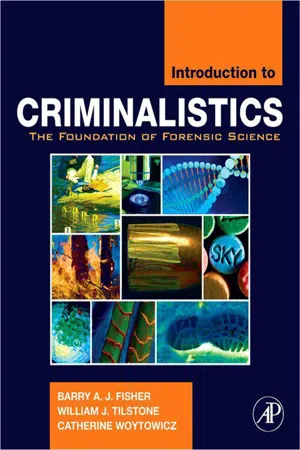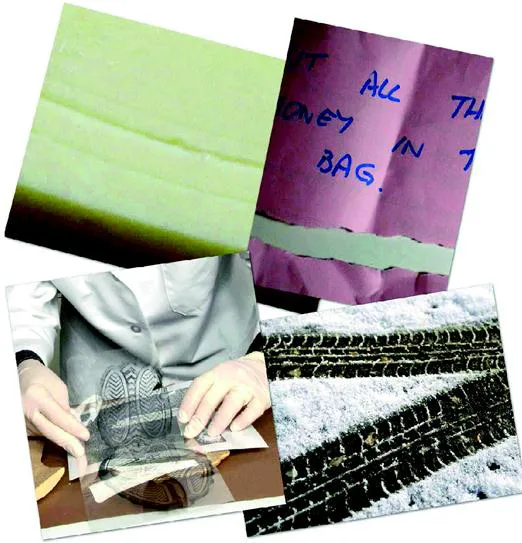![]()
Section II
Pattern Evidence
Outline
Chapter 2 Introduction to Pattern Evidence
Chapter 3 Firearms
Chapter 4 Fingerprints
Chapter 5 Documents
Chapter 6 Physical Evidence
Chapter 7 Hair and Fiber
![]()
Chapter 2
Introduction to Pattern Evidence
Tool Marks and Impressions
Glossary
Class characteristic an identifying feature that puts an item in a group.
Compression a mark made by pressing a tool into a softer material.
Cutting a combination of compression and sliding with a tool that severs the material.
Exclusion no match between a tool mark and a tool suspected of producing it; a term used to indicate a lack of association between evidence or a suspect and a crime scene.
Exemplar a known sample.
Identification a match between a tool mark and the tool that produced it; a match between evidence and a crime scene.
Individual characteristic an identifying feature that distinguishes a member of a class. For example, a worn shoe will exhibit a wear pattern unique when compared to all other shoes of the same manufacturer.
Sliding a tool mark made by scraping a tool across a surface, making tiny lines.
Striations lines made by scraping or sliding a tool across a surface.
Tool mark any impression, cut, gouge, or abrasion caused by a tool coming into contact with another object.
Transfer leaving evidence behind or moving evidence from one surface to another by contact.
Examples of pattern evidence. Clockwise from top: Marks in cheese made by damaged slices; hold-up note compared to torn-off papers; tire tracks in snow; technician lifting sole impression from shoe. Cheese and hold-up note original work of author; tire track from Stockxpert; footprint courtesy of Los Angeles County Sheriff’s crime laboratory.
Case Study
The Wood-Chipper Homicide
Helle Crafts lived with her husband Richard and three children near Newtown, Connecticut. But all was not well with the Crafts, despite their glamorous life: She was an attractive blond Danish-born flight attendant, and he was a pilot. Helle believed that Richard was cheating on her and hired a private investigator to check it out. The investigator, Keith Mayo, became concerned at a cessation of contact with his client and called the Newtown police on December 1, 1986, to report that Helle had disappeared and he feared she might have been murdered by her husband. The police investigated and were informed by Richard that he had not seen his wife since November 19, when she left to visit her sister. At first the police were not overly concerned, but that changed as their interviews produced evidence of Richard’s infidelity. When he agreed to take, and passed, a lie detector test, they were inclined to treat the matter as a missing person case.
Further inquiries revealed inconsistencies in Richard’s accounts of events around the time of Helle’s disappearance. The police and Keith Mayo began to dig deeper, almost literally in Mayo’s case, as he searched through the city garbage dump to recover pieces of carpet from the Crafts’s home that Richard said he had discarded because of a kerosene spill. Mayo did find the carpet, but the hoped-for blood traces were not found. What did happen was that the interest of the media in the case was raised, and the state attorney-general had the investigation transferred to the state police.
They began by examining Richard’s financial records and found two items of interest: a credit card purchase of a large-capacity freezer and a payment of $900 for machinery rental. Why did he need an industrial-size freezer, and what was the rental for? Police were granted a search warrant for the Crafts’s home and went there on Christmas Day, 1986, accompanied by Dr. Henry Lee. Richard and the children were vacationing in Florida at the time. Traces of blood were found at several locations and on discarded towels.
The case that Richard had murdered Helle was building, even without the body. But the credit card records resulted in a significant and gruesome lead: The rental item was a large wood chipper, which Richard had collected from the rental depot on November 19. Things were falling into place. There was a record of a utility worker seeing a wood chipper being used in the midst of a snowstorm that day. The worker was interviewed and took police to the scene where they found not just piles of wood chippings but papers with Helle’s name, blond hairs, bone fragments, pieces of cloth, and various unidentified materials. Everything was collected, cataloged, and taken to the state crime laboratory for examination. The chipper was found at the rental store and taken to the crime laboratory; a search of the lake near the site produced a chain saw with its serial number filed off; other fragmented human remains were uncovered.
Piecing the elements together, police postulated that Richard had beaten Helle to death in their bedroom and then moved the body to the industrial freezer. He next used the chain saw to cut up the body into smaller pieces, which were stored in the freezer before being put through the chipper. He had intended that the fragments spray into the lake, but many fell out on dry land to be discovered during the police search.
It was a compelling story that fit the known circumstances. Richard Crafts was charged and the trial set. To complete the case, it was necessary to link the physical evidence to the tools — the chain saw and the chipper—and so to Richard Crafts. Dr. Lee was able to show that the various fragments of bone, teeth, and human tissue had all been made by the chipper. He also showed that the chain saw not only had traces of teeth, blond hair, and human tissues, but also had fibers that could have come from the carpet in the Crafts’s bedroom. The laboratory was able to restore the serial number of the chainsaw and trace its purchase to Richard Crafts.
Eventually, almost 3 years from the date of Helle’s disappearance, Richard Crafts was convicted of her murder.
Introduction
One of the most important techniques used by the forensic scientist is observation. This skill is applied in two different ways: the search of a scene or an item in the laboratory to identify objects or features that may yield significant evidence on further testing; and a major category of evidence that we can loosely describe as pattern evidence. The basic principle underpinning pattern evidence is that physical objects can leave impressions on other materials, and examination of the impressions or marks can be used to draw conclusions as to whether or not the mark was made by the object of interest. Hence, without minimizing its importance, one of the ways criminalists process evidence is actually by using a skill you learned in kindergarten: pattern matching. Some examples are given in Table 2.1 and the introductory illustration. However, forensic examiners must do it at a much more exacting level.
Table 2.1
Some Examples of Pattern-Matching Evidence
| Source | Mark or Impression | Application |
| Vehicle tires | Tracks on a roadway, soil, snow | Place a specific vehicle at a scene. Identify a vehicle from make of tire and vehicle track width and wheel base dimensions. |
| Tools | Impression on object made by the tool, or where the tool was applied | Link pry bar to door or window at scene of break-in. |
| Footwear | Impressions in soil, marks in blood, marks on hard surface | Place footwear at location. |
| Firearms | Tool mark striations on fired ammunition, impression marks from firing mechanism | Associate bullets and cartridge cases with specific weapon. See Chapter 3, “Firearms.” |
| Fingerprints | Ridge patterns left on objects | Identify person who tou... |

